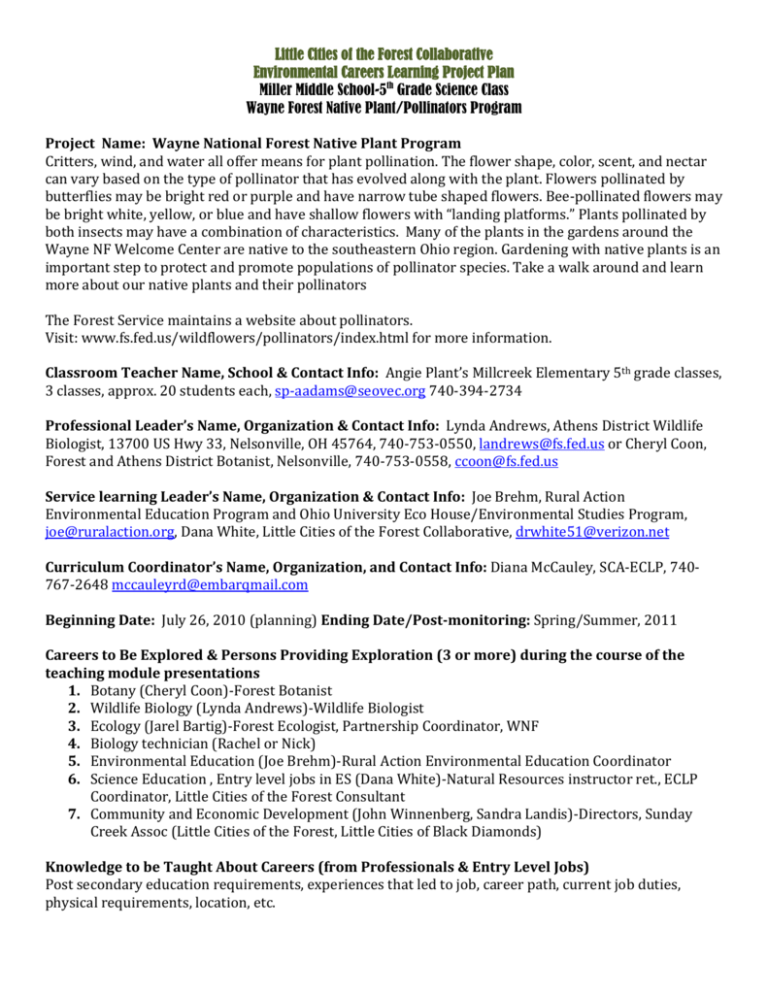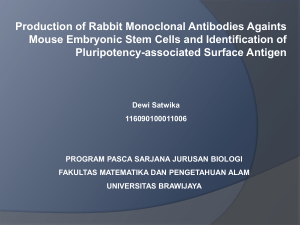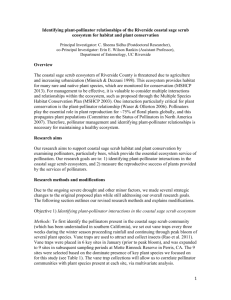Little Cities of the Forest Collaborative
advertisement

Little Cities of the Forest Collaborative Environmental Careers Learning Project Plan Miller Middle School-5th Grade Science Class Wayne Forest Native Plant/Pollinators Program Project Name: Wayne National Forest Native Plant Program Critters, wind, and water all offer means for plant pollination. The flower shape, color, scent, and nectar can vary based on the type of pollinator that has evolved along with the plant. Flowers pollinated by butterflies may be bright red or purple and have narrow tube shaped flowers. Bee-pollinated flowers may be bright white, yellow, or blue and have shallow flowers with “landing platforms.” Plants pollinated by both insects may have a combination of characteristics. Many of the plants in the gardens around the Wayne NF Welcome Center are native to the southeastern Ohio region. Gardening with native plants is an important step to protect and promote populations of pollinator species. Take a walk around and learn more about our native plants and their pollinators The Forest Service maintains a website about pollinators. Visit: www.fs.fed.us/wildflowers/pollinators/index.html for more information. Classroom Teacher Name, School & Contact Info: Angie Plant’s Millcreek Elementary 5th grade classes, 3 classes, approx. 20 students each, sp-aadams@seovec.org 740-394-2734 Professional Leader’s Name, Organization & Contact Info: Lynda Andrews, Athens District Wildlife Biologist, 13700 US Hwy 33, Nelsonville, OH 45764, 740-753-0550, landrews@fs.fed.us or Cheryl Coon, Forest and Athens District Botanist, Nelsonville, 740-753-0558, ccoon@fs.fed.us Service learning Leader’s Name, Organization & Contact Info: Joe Brehm, Rural Action Environmental Education Program and Ohio University Eco House/Environmental Studies Program, joe@ruralaction.org, Dana White, Little Cities of the Forest Collaborative, drwhite51@verizon.net Curriculum Coordinator’s Name, Organization, and Contact Info: Diana McCauley, SCA-ECLP, 740767-2648 mccauleyrd@embarqmail.com Beginning Date: July 26, 2010 (planning) Ending Date/Post-monitoring: Spring/Summer, 2011 Careers to Be Explored & Persons Providing Exploration (3 or more) during the course of the teaching module presentations 1. Botany (Cheryl Coon)-Forest Botanist 2. Wildlife Biology (Lynda Andrews)-Wildlife Biologist 3. Ecology (Jarel Bartig)-Forest Ecologist, Partnership Coordinator, WNF 4. Biology technician (Rachel or Nick) 5. Environmental Education (Joe Brehm)-Rural Action Environmental Education Coordinator 6. Science Education , Entry level jobs in ES (Dana White)-Natural Resources instructor ret., ECLP Coordinator, Little Cities of the Forest Consultant 7. Community and Economic Development (John Winnenberg, Sandra Landis)-Directors, Sunday Creek Assoc (Little Cities of the Forest, Little Cities of Black Diamonds) Knowledge to be Taught About Careers (from Professionals & Entry Level Jobs) Post secondary education requirements, experiences that led to job, career path, current job duties, physical requirements, location, etc. Identified Science 5 Academic Content Standard(s) To Be Addressed by the Project: Life Sciences indicators 1-6 Diversity and Interdependence of Life: TBD which indicators to target. Probable targets: o Indicator 4 Summarize that organisms can survive only in ecosystems in which their needs can be met. The work has different ecosystems and district ecosystems support the lives of different organisms. (focus on temperate forest ecosystem) o Indicator 6 Analyze how all organisms including humans cause changes in their ecosystems and how these changes can be beneficial, neutral, or detrimental. Scientific Inquiry Doing Scientific Inquiry o Indicator 3: Use evidence and observations to explain and communicate the results of investigations Scientific Ways of Knowing Science and Society o Indicator 6: Identify a variety of scientific and technological work that people of all ages, backgrounds and groups perform Identified Science 4 Academic Content Standard(s) To Be Addressed by the Project: revisited at grade 5 as a result of OAA results-probable targets Life Sciences indicators o Indicator 1 Compare the life cycles of different plants including germination, maturity, reproduction, and death o Indicator 2 Relate plant structures to their specific functions, e.g. growth, survival, reproduction o Indicator 3 Classify common plants according to their characteristics, e.g. leaves, flowers, seeds, roots, etc. o Indicator 5 Describe how organisms interact with one another in various ways, e.g. many plants depend on animals for carrying pollen or dispersing seeds. Activities that will relate directly to the Academic Content Standard(s): 1 field day (Wayne), 1 field day (Millcreek Elementary) 4+ classroom presentations to complement teaching done in the classes by the participating teacher; Pollinator Garden spring project McCauley and Plant will meet and set the learning standards and objectives to be taught for each day. This will set the direction for each presenter. The FS Pollinator Live website will be our main resource. This site links to lessons plans developed by the Smithsonian which are geared to meet national standards. Note: Regular school day hours are: 8:30-3:30 but instructional hours are 9:05-3:05. Science 5 (1) 9:0510:25, (2) 11:00-11:40 and 1:05-1:50, (3) 1:50-3:05. MES is willing to modify the schedule for presenters so that they have three sequential 50 min sessions either AM or PM. Exception: 9/15, 40 min sessions AM only-MES on modified schedule. Field Day on the Wayne NF Monarch butterfly tagging and field observation at Monroe Outlook, Andrews and technician and/or Regina to assist) Incorporate “monarch live” program? Native plant identification day: Wayne NF Native Plant nursery and wildflower trail Wildflower walk, seed germination, nature journaling, plant seed to take home Pollinator Garden Service Learning project at MES, White/Brehm Project sessions (regular class time, field work, field trip, etc.) Minimum of 10-15 Hrs Contact Time Date Description of Session 9/2 Introduction to ECLPenvironmental career focus DAY 1 Plant biology and pollinators Why pollinators are needed Flower physiology DAY 2 Identification of Pollinators Why different types are needed Different ecosystems and regions DAY 3 Field Day 1.5 hrs at each location Life cycle of a butterfly; butterfly identification Native plants; seed collection and planting DAY 4 Little Cities of the Forest/Sunday Creek How local resources have impacted our history and our current environment. DAY 5 Web of Life Activity DAY 6+ Service learning project at MES 9/13 9/15 9/17 10/5 10/20 TBD Professionals/Resource People Diana McCauley Location Times MES Joe Brehm MES Regular Sci 5 schedule Modified block schedule all day Joe Brehm MES Modified block schedule all day Lynda Andrews Cheryl Coon Need photography from Gary Chancey Monroe Outlook Wayne HQ Field trip schedule Dana White John Winnenberg Sandy Landis MES Jarel Bartig MES 40 min AM classes Dana White MES Spring 2011 Ways Science & Technology will be explored in project (McCauley/Plant): Following the presentations and field trip, students will complete a computer-based activity exploring careers in Environmental Science in the MES computer lab using the Vocational Information Services Career Exploration Guides and Resources website Evaluation Design (McCauley/Plant) Pre and post assessments o Environmental career awareness consensogram-self reflection: “How much do you know about careers in Environmental Science?” o Journal entries, exit slips, and classroom assessments to measure student learning on other learning targets-to be designed and implemented by Science 5 teacher o Computer-based student career exploration results-to be implemented by Christina Masso, MES Computer Instructor o Expository writing piece following the project’s fall activities-student reflection on “How has this project contributed to your learning? Would you recommend this project for other students?”-to be implemented by Science 5 teacher Project evaluation by classroom teacher, visiting professionals and ECLP staff Plans for tie in to Place-Based Education about the Little Cities Microregion (SCA) Elaine’s Garden Wildcat Hollow Rutherford Wetland Wayne NF Welcome Center/wildflower trail & native plant nursery Documentation/Publicity of Activities (photo, videos, school newsletter, local media, etc.) Project Poster (done) Wayne NF Success Story (Bartig) Southern Local School Board report (Plant)-completed in Oct, 2010 Any Parental Permission Requirements Anticipated including release for photos and/or student writings for publication: White/Plant Copies to: Mary Lou Wycinski, MES Principal Angie Plant, MES Science 5 teacher Jarel Bartig, WNF Partnership Coordinator Dana White, ECLP Coordinator Lynda Andrews, ECLP WNF Contact










